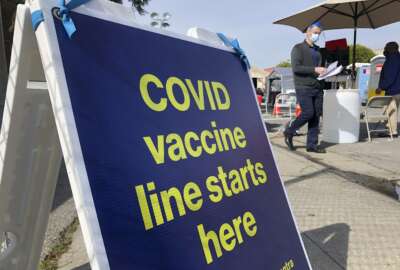
DMV leaders want federal government to create plan for vaccinating federal employees
In today's Federal Newscast, national capital area leaders say the federal government should take the lead in directly vaccinating the region's federal workers.
To listen to the Federal Newscast on your phone or mobile device, subscribe in PodcastOne or Apple Podcasts. The best listening experience on desktop can be found using Chrome, Firefox or Safari.
- National capital area leaders say the federal government should take the lead in directly vaccinating the region’s federal workers. The request comes directly from D.C. Mayor Muriel Bowser, Virginia Governor Ralph Northam and Maryland Governor Larry Hogan. They’re asking the Department of Health and Human Services to set aside enough doses for the region’s 30,000 federal workers who have priority for the COVID-19 vaccine. And they want HHS to set up and operate a central vaccination site specifically for essential federal workers.
- The Department of Veterans Affairs says it got an extra shipment of 200,000 doses of COVID-19 vaccine this week. That’s on top of the 125,000 doses VA has been receiving every week or so. VA is providing vaccines at 215 sites. Nearly 1.1 million veterans, VA employees and others have received at least one dose of the vaccine so far. Over 250,000 VA employees have gotten their first dose. About 80% of them are fully vaccinated with a second dose.
- The departments of Defense and Health and Human Services have reached a deal to buy another 100 million doses of COVID-19 vaccine. Under the new purchase agreements, the government will pay another $2 billion to Pfizer, and another $1.7 billion to Moderna. The deal, as announced by the Pentagon last night, brings the total number of doses the federal government is buying from the companies to 600 million. HHS and DoD said they have separate plans to buy doses from four other drugmakers if and when their vaccine candidates get emergency use authorization from the FDA.
- The Defense Department is outpacing the public in COVID vaccine efficiency. About 82% of coronavirus vaccines shipped to military bases have made it into Defense Department employees’ arms. That outpaces the national efficiency average of 68%. Each individual state is currently in charge of the vaccination process. Pentagon spokesman John Kirby said to date DoD has shipped about one million vaccines. A little more than 800,000 employees have gotten the shot. The vaccine is voluntary for those in the military because it was approved under an emergency-use authorization. (Federal News Network)
- Soldiers and families who’re dealing with substandard housing on half a dozen Army bases should start to see some major improvements by this summer. Army officials told Federal News Network a new round of private investment worth more than a billion dollars should be available by the end of March. That should let developers get started on renovations to 12,000 existing homes by May. Construction on another 1,200 brand new housing units is expected to start as soon as this Fall. (Federal News Network)
- At least one Senator says that post-COVID, maybe the government will never need as much office space as it has now. That’s from Sen. Ben Cardin (D-Md.). He’s working on a bill to require improvement of energy efficiency in new and existing federal facilities. He also said some permanent shrinkage might occur. “Our footprint on the need of space should be dramatically reduced. And I think going forward we need to put that into the equation. That will help the taxpayers of this country and will also, I think, make government services much more efficiently provided.”
- A bipartisan group of House members want to expand the number of people eligible for federal law enforcement benefits. Lawmakers reintroduced the Law Enforcement Officers Equity Act. The bill would expand the definition of a federal law enforcement officer to include 30,000 police officers at various federal agencies. That would include police officers at the Department of Veterans Affairs, IRS employees who collect delinquent taxes, employees at the U.S. Postal Inspection Service and others. It would allow these employees to retire after 20 years of service at age 50 or after 25 years of service at any age.
- The House Oversight and Reform Committee is putting the spotlight on postal reform. Mark your calendars. Postmaster General Louis DeJoy and the new USPS Board of Governors Chairman Ron Bloom will testify before the committee on February 24. They’ll be joined by agency inspector general Tammy Whitcomb and the president of the American Postal Workers Union Mark Dimondstein. They’ll discuss how to put the agency on firmer financial footing. Lawmakers introduced the USPS Fairness Act earlier this month, which would eliminate the agency’s mandate to pre-fund retiree health benefits well into the future.
- The Census Bureau is hiring temporary workers to run a quality check of the 2020 census. Post-Enumeration Survey hires will begin their work in June, and will estimate how many people and housing units were missed or doubled-counted during last year’s field operations. The bureau already laid the groundwork for this phase of the count last year, when it drew up an address list separate from the one it gave to census enumerators. The bureau expects to release the first results of the survey this December.
- The Professional Services Council named David Broome as its new executive vice president for government relations. Broome starts on February 15 in this new role that PSC created after Alan Chvotkin left in December. He comes to PSC after spending almost the last two years as the senior vice president of government relations for the Israel Aerospace Industries. Along with IAI, Broome also worked in the George W. Bush administration, where he served as special assistant to the President for legislative affairs, as deputy assistant secretary of defense for Senate affairs and as deputy assistant administrator for government and industry affairs in the Federal Aviation Administration.
- It’s going to take a little longer to get the consolidated federal acquisition website ready for prime time. The Beta.SAM.gov platform will stay in beta mode for an extra month. The General Services Administration announced it will need until May 24 to merge the legacy SAM.gov platform into the Beta.SAM.gov environment. After the merger, the system will be known only as SAM.gov, which will include four of the eventual seven databases at launch. GSA had planned to move into the new environment at the end of April, but decided it needed an extra month to run both systems in parallel.
Copyright © 2025 Federal News Network. All rights reserved. This website is not intended for users located within the European Economic Area.
Eric White
Eric White is news anchor and Federal Drive producer at Federal News Network.
Follow @FEDERALNEWSCAST




